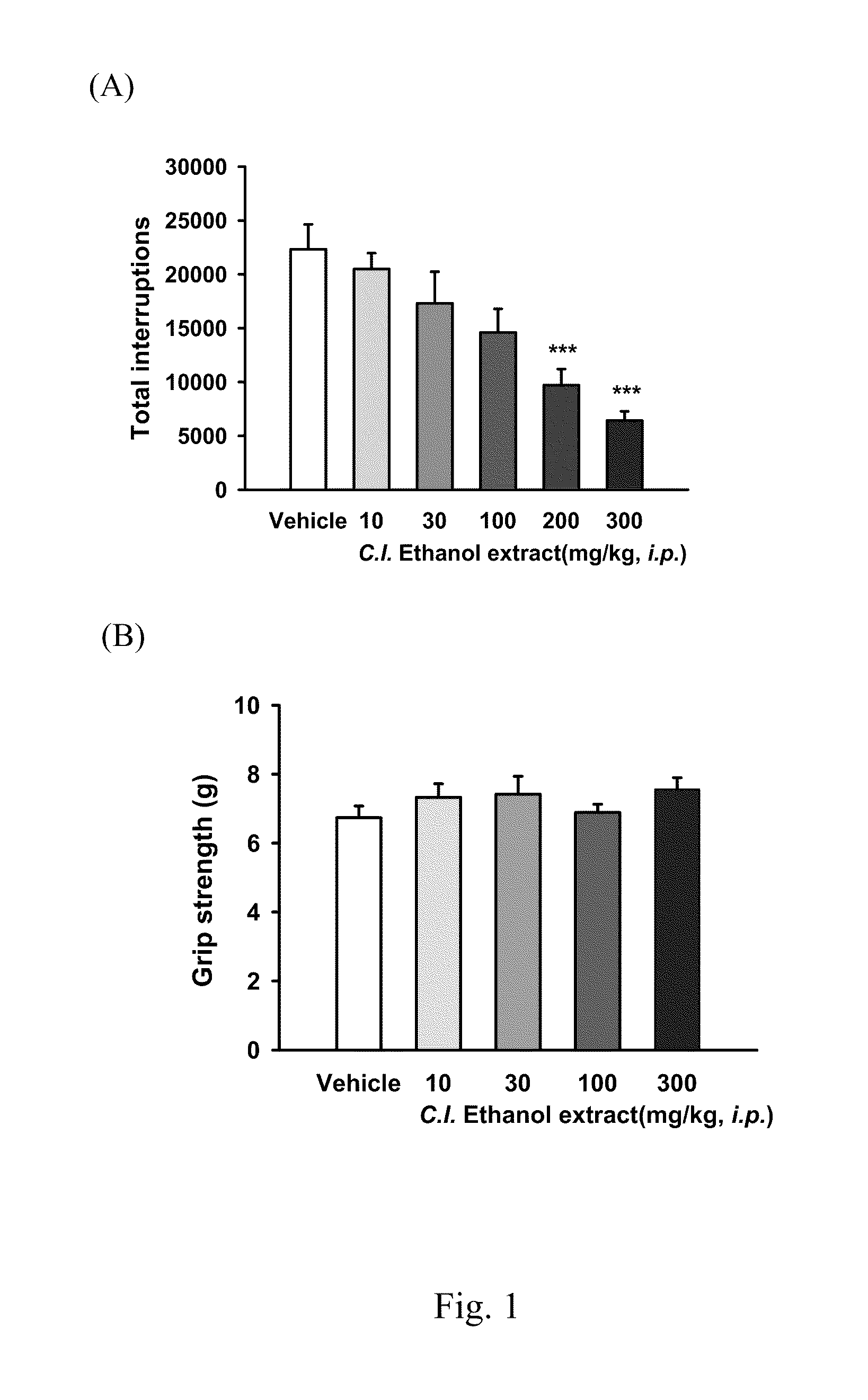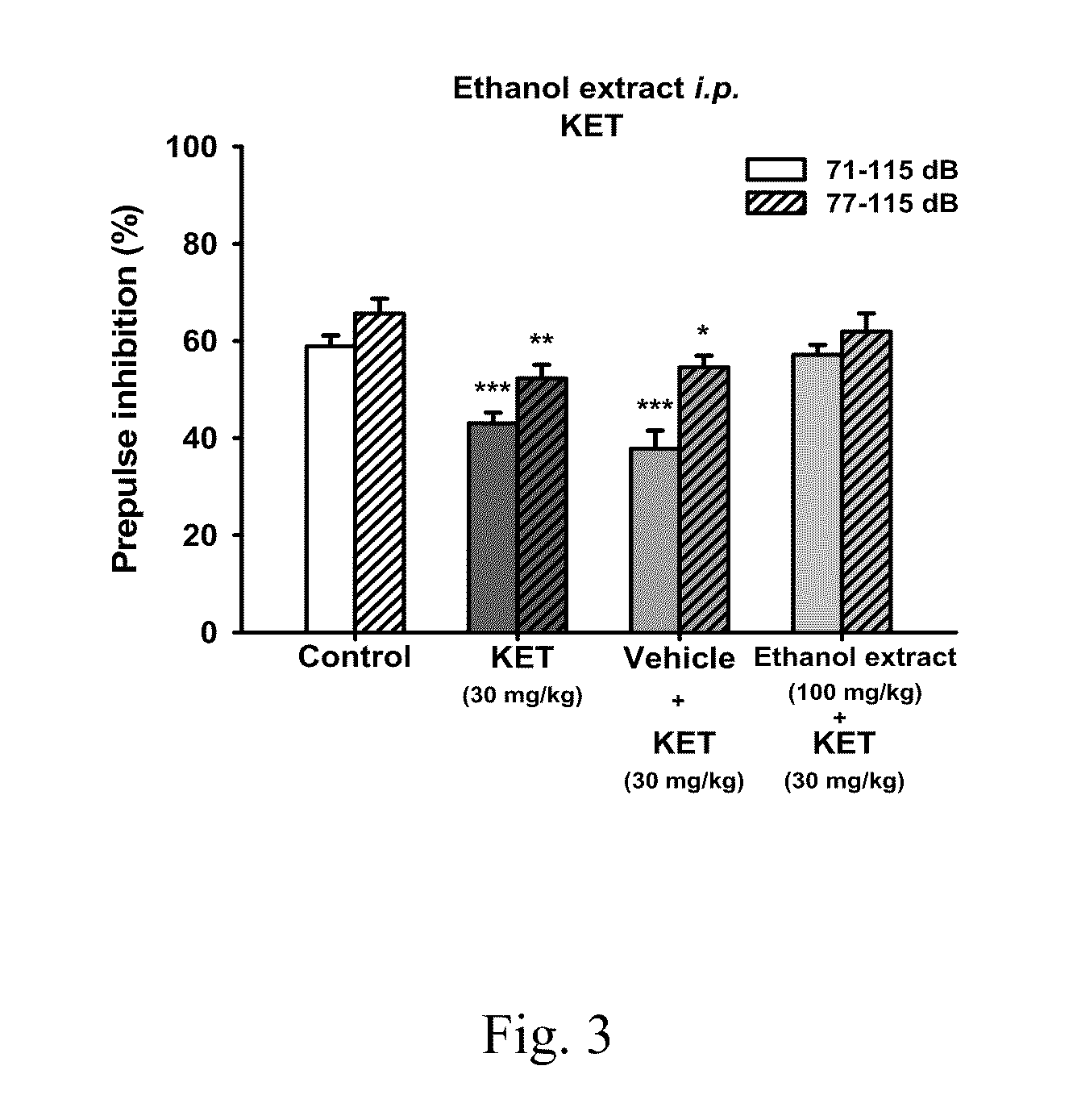Use of clerodendrum sp. for treating tic disorders or psychiatric disorders with sensorimotor gating deficits
a technology of clerodendrum and sp., which is applied in the direction of biocide, plant/algae/fungi/lichens ingredients, biocide, etc., can solve the problems of suboptimal treatment effectiveness and side effects, no scientific literature or reports indicate, etc., and achieve the effect of treating sensorimotor gating deficits
- Summary
- Abstract
- Description
- Claims
- Application Information
AI Technical Summary
Benefits of technology
Problems solved by technology
Method used
Image
Examples
example 1
Preparation of an Extract of Clerodendrum inerme
[0031]Clerodendrum inerme were harvested in mangrove marshes in the riverside of Taiwan. The leaves were collected and air dried. The dried leaves (3.0 kg) were grinded and repeatedly extracted with 95% EtOH (10 L) three times, for each of which extraction the leaves were soaked in ethanol for about one week. The combined EtOH layers were evaporated under reduced pressure to give a residue (246 g) which was used to conduct the subsequent animal experiments.
example 2
Effect of the Extract of Clerodendrum inerme on the Motor Functions of Mice
[0032]2.1 Animal
[0033]Male ICR mice (25-35 g) mice were used for behavioral studies. They were bred, housed and maintained in the animal facility center with temperature- and humidity-controlled and 12:12 light dark cycle in National Taiwan University, College of Medicine (NTUMC). All animal experiments were carried out in accordance with the guidelines established by the Institutional Animal Care and Utilization Committee of NTUMC.
[0034]2.2 Motor function Methamphetamine (2 mg / kg) was injected into mice to induce hyperlocomotion in the mice as a typical model for behavioral experiments. After injection of methamphetamine, the mice were administrated by i.p. injection of vehicle (0.1 ml dimethylsulfoxide) or the C.I. extract at a range of doses from 10 to 300 mg / kg. After 15 minutes, the treated mice were then subjected to tests for locomotor activity and grip strength, respectively.
[0035]The locomotor activi...
example 3
Effect of the Extract of Clerodendrum inerme in One Case Report
[0047]A 13-year-old girl was admitted to National Taiwan University Hospital (NTUH) due to intractable, rhythmic 3-Hz jerky movements of four limbs for four months. Her actions were insuppressible and lasted for hours with consciousness preserved. She also complained of dizziness, headaches and nausea. No aura or triggered factors were noted. She had visited the outpatient clinic of another medical center where haloperidol was increased in dosage and diazepam was added, but in vain. The electroencephalography and brain computed tomography at that hospital were negative. Tracing the past history, this patient had been healthy until age 2, when she suffered from right frontal skull fracture, without intracranial hemorrhage, due to trauma. She started to develop focal epilepsy and was treated with regular antiepileptic drugs. The regimen was shifted to lamotrigine and clonazepam after age 7, when she experienced status epil...
PUM
 Login to View More
Login to View More Abstract
Description
Claims
Application Information
 Login to View More
Login to View More - R&D
- Intellectual Property
- Life Sciences
- Materials
- Tech Scout
- Unparalleled Data Quality
- Higher Quality Content
- 60% Fewer Hallucinations
Browse by: Latest US Patents, China's latest patents, Technical Efficacy Thesaurus, Application Domain, Technology Topic, Popular Technical Reports.
© 2025 PatSnap. All rights reserved.Legal|Privacy policy|Modern Slavery Act Transparency Statement|Sitemap|About US| Contact US: help@patsnap.com



